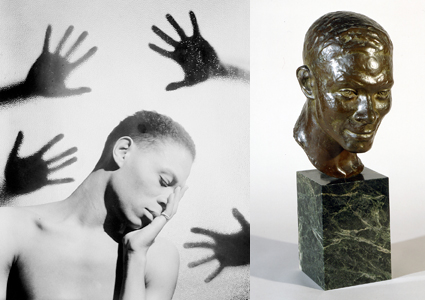
These two portraits of performer Jimmie Daniels are the second set in our Face Lift: Caption This! contest. How do these two portraits—the photograph by George Platt Lynes and the bronze sculpture by Richmond Barthé—convey different aspects of Mr. Daniels’ persona? Imagine the dashing young man in Paris and Harlem. Let your creativity flow and suggest a caption for this double image of the entertainer.
Read the full terms and conditions for the Face Lift: Caption This! contest.
Curatorial Perspective
Though artists often create portraits with paint, these two works depicting American singer and entertainer Jimmie Daniels (1910 – 1984) employ different media. In addition to an artist’s technical ability, qualities inherent to the materials also contribute to the efficacy and suggestive power of a portrait.
Jimmie Daniels was a performer and fashionable master of ceremonies in Paris before opening his own supper club in Harlem in the 1930s. His was a popular stop on the circuit of raucous New York nightlife. Known as a handsome and dashing character, several artists chose to portray Daniels in their work. Harlem Renaissance artist, Richmond Barthé, studied both painting and sculpture, but turned almost exclusively to bronze works after 1927. Barthé chose Daniels as his subject on more than one occasion stating that he found the performer’s smile particularly engaging. As a portraitist, Barthé was considered among the best in New York, his masterful control of his medium enabled him to capture not only the details of Daniels’s facial features, but also the essence of his spirit.
In contrast to Barthé’s straightforward presentation of his subject, photographer George Platt Lynes portrays Daniels from the side, with his head in his hands and surrounded by several shadowed hands in the background. This portrait of Daniels seems to accentuate his theatrical nature. The lighting gracefully captures the smooth planes and contours of Daniels’s body and face. Though many of his portraits were for commercial use in publications such as Vogue and Harper’s Bazaar, Lynes often incorporated elements of Surrealism or homo-eroticism into his work, especially in his portraits of entertainers.
Published September 16, 2010

